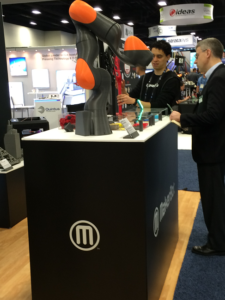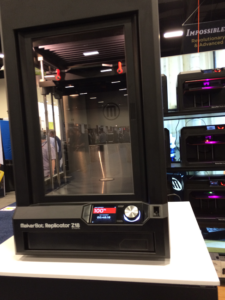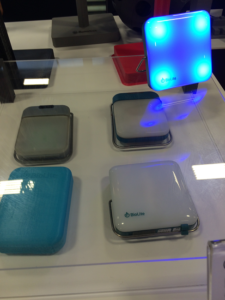While at RAPID + TCT last week in Fort Worth, Texas, in between attending keynotes and press conferences and checking out the latest 3D printers, I was able to sit down and meet with a handful of the more than 300 exhibitors at the conference, including MakerBot.
MakerBot, which recently introduced its new comprehensive 3D printing certification program, was not releasing any new 3D printers at RAPID, but did have several new prints and applications to showcase, starting with the 3.2 kg KUKA robotic arm, which took 119 hours to print using TPLA material and was the focus of a video graphic case study MakerBot published this winter regarding KUKA’s future in manufacturing, which has been aided by MakerBot 3D printers.
Grant Parker, the Senior Manager of Demand Generation and Channel Marketing at MakerBot Industries, said that KUKA, which used 3D printing right from the beginning, even named the company’s Replicator Z18 3D printer the “employee of the month.”
Parker explained, “KUKA represents an entire ecosystem of 3D printing.”
He explained that 3D printing is putting the process of creating “into the hands of people at all levels,” and how this kind of access is important in terms of adoption.
 MakerBot, which promises “repeatable results,” did release a new extruder head, which features an open platform for third party materials. This makes it possible for users to explore the advantages 3D printing has to offer in a safe way with any third party filament.
MakerBot, which promises “repeatable results,” did release a new extruder head, which features an open platform for third party materials. This makes it possible for users to explore the advantages 3D printing has to offer in a safe way with any third party filament.
The Experimental Extruder head, which attaches to the Replicator+, offers a few different types and styles of nozzles, and while it’s the same to hook up as the company’s Smart Extruder+, Parker notes that it’s “definitely for experienced users.” However, the platform is more open when it’s combined with the MakerBot Labs platform, so you can 3D print a part at the office and then head home to use the new Experimental Extruder.
Parker mentioned that the unique materials at the company’s booth, such as wood, limestone, and copper, were from colorFabb, and then showed me some of the most recent 3D print examples from MakerBot customers on the booth’s use case table.
Besides the KUKA arm, which originally needed a prototype to test for tolerance, the first use case was the solar-powered SunLight for outdoor activities, like camping, from BioLite, which develops affordable, durable products that are designed to harness nearby energy in order to cook, charge, and light households that are off the grid. Parker told me that by using 3D printing, the company saved $7,000 in bringing this product to market.
 StringKing, a small sports startup, needed to find a way to compete with other similar companies, and worked with MakerBot on several design iterations in order to get its product – a lacrosse head – out faster and at less cost.
StringKing, a small sports startup, needed to find a way to compete with other similar companies, and worked with MakerBot on several design iterations in order to get its product – a lacrosse head – out faster and at less cost.
“With MakerBot, they were able to get things moving for themselves,” Parker said.
At this point, MakerBot Senior Industrial Designer Felipe Castaneda joined the conversation, and mentioned that 3D printing makes it possible to achieve faster iteration processes for products, as “one 3D printed object is worth 1,000 words” since you can actually hold an “idea in your hands.”
He explained that these use case partnerships are “about trying to help someone in the early development process get there faster.”
“We’re all creative beings,” Castaneda told me. “It’s about who has the guts to make the idea happen.”
Castaneda mentioned a design study project for a 3D printed bicycle saddle (seat) that the company’s designers worked on several months ago using Tough PLA material. He said that the study was successful, because 3D printing can help “actually change ideas fast.”
Whether you’re prototyping an idea or making end-use products, 3D printing makes it possible to learn by doing. Castaneda is a big proponent of making as many mistakes as you can during the process, so that by the time you get past the 3D printed prototype stage, you will “already know so much more.”“The idea of the iterative process,” Castaneda told me, “is to get you through the messy parts.
“It’s exciting to make mistakes and own it…learn from it.”
Moving back to the bike saddle, Castaneda said that he was able to use 3D printing to quickly move past the sketching phase to the prototyping phase of the project, and that the “most interesting part” for him was that he ended up making a seat that was “smoother than expected.”
When it comes having prototypes you can actually “work with” and “be messy about,” Castaneda said, “It’s about being able to say, let’s try something and see how it works.”
Stay tuned for more on 3DPrint.com’s visit to RAPID last week.
Discuss this and other 3D printing topics at 3DPrintBoard.com or share your thoughts in the comments below.
[All photos: Sarah Saunders unless otherwise noted]
Subscribe to Our Email Newsletter
Stay up-to-date on all the latest news from the 3D printing industry and receive information and offers from third party vendors.
You May Also Like
Precision at the Microscale: UK Researchers Advance Medical Devices with BMF’s 3D Printing Tech
University of Nottingham researchers are using Boston Micro Fabrication‘s (BMF) 3D printing technology to develop medical devices that improve compatibility with human tissue. Funded by a UK grant, this project...
3D Printing Webinar and Event Roundup: April 21, 2024
It’s another busy week of webinars and events, starting with Hannover Messe in Germany and continuing with Metalcasting Congress, Chinaplas, TechBlick’s Innovation Festival, and more. Stratasys continues its advanced training...
3D Printing Webinar and Event Roundup: March 17, 2024
It’s another busy week of webinars and events, including SALMED 2024 and AM Forum in Berlin. Stratasys continues its in-person training and is offering two webinars, ASTM is holding a...
3D Printed Micro Antenna is 15% Smaller and 6X Lighter
Horizon Microtechnologies has achieved success in creating a high-frequency D-Band horn antenna through micro 3D printing. However, this achievement did not rely solely on 3D printing; it involved a combination...







































